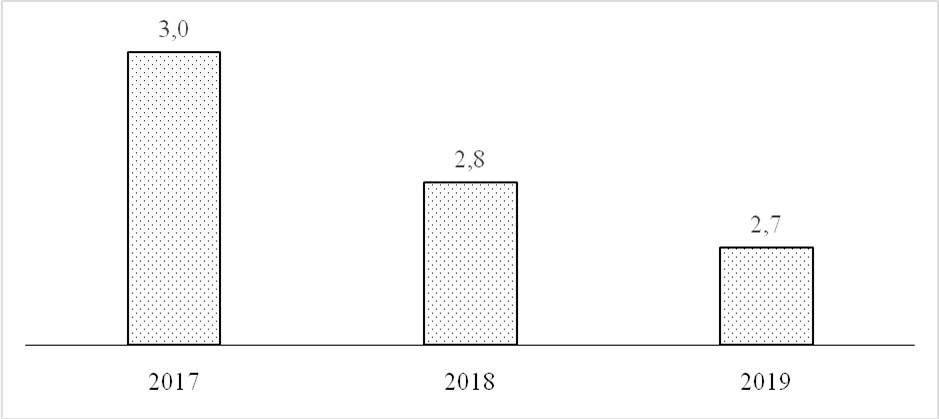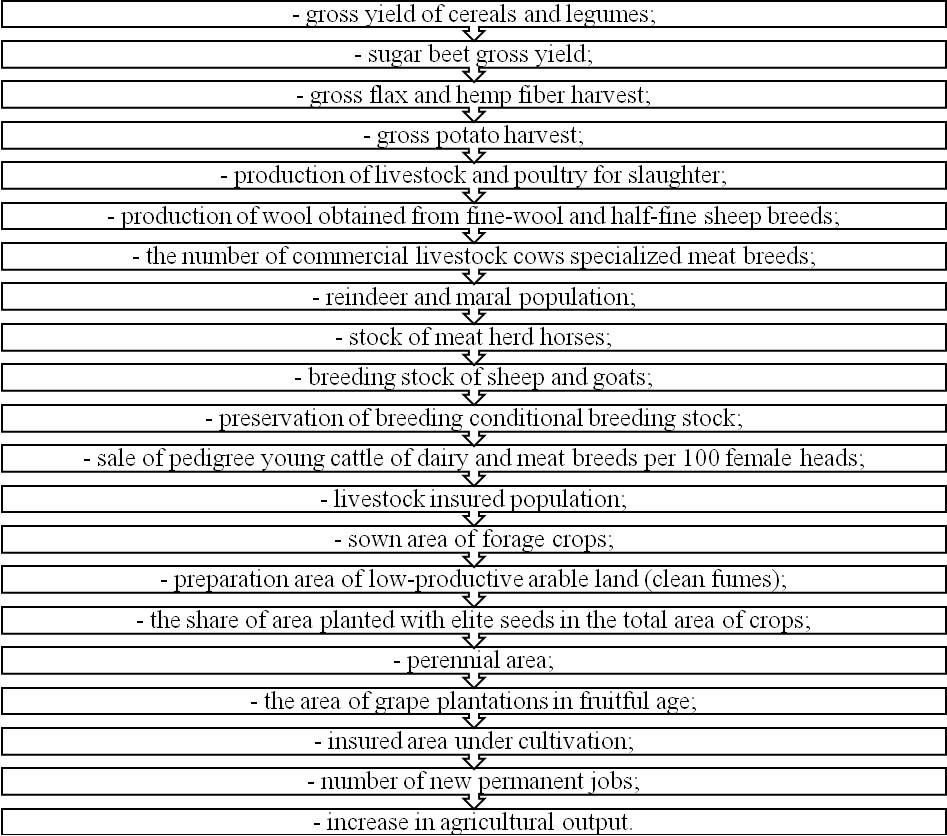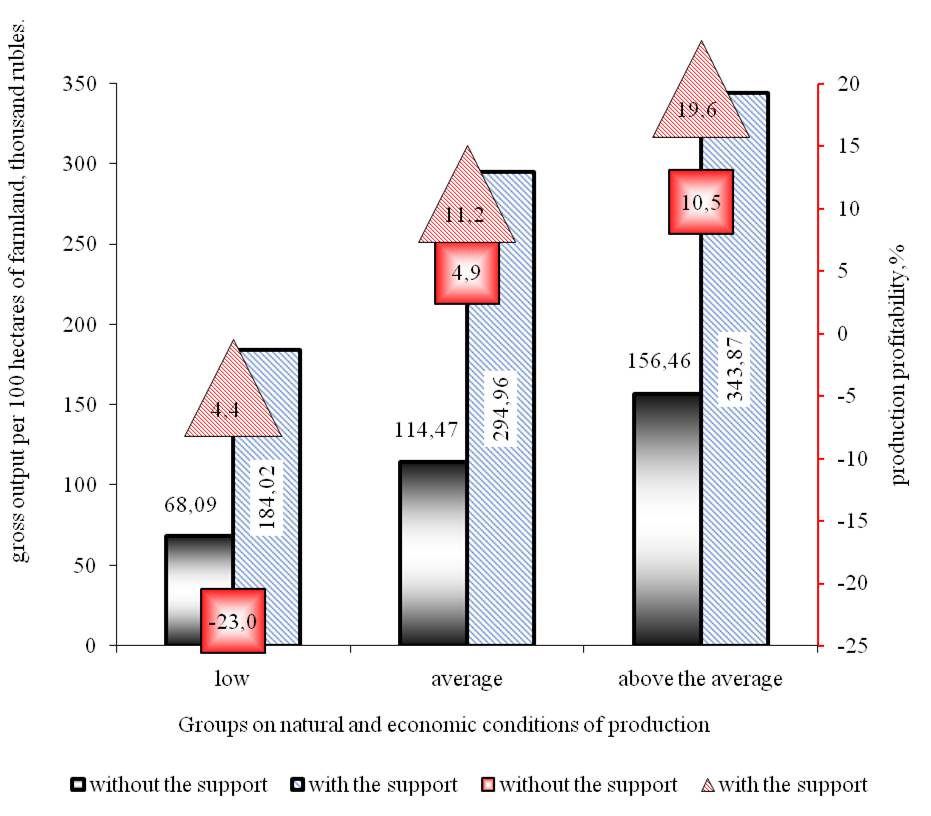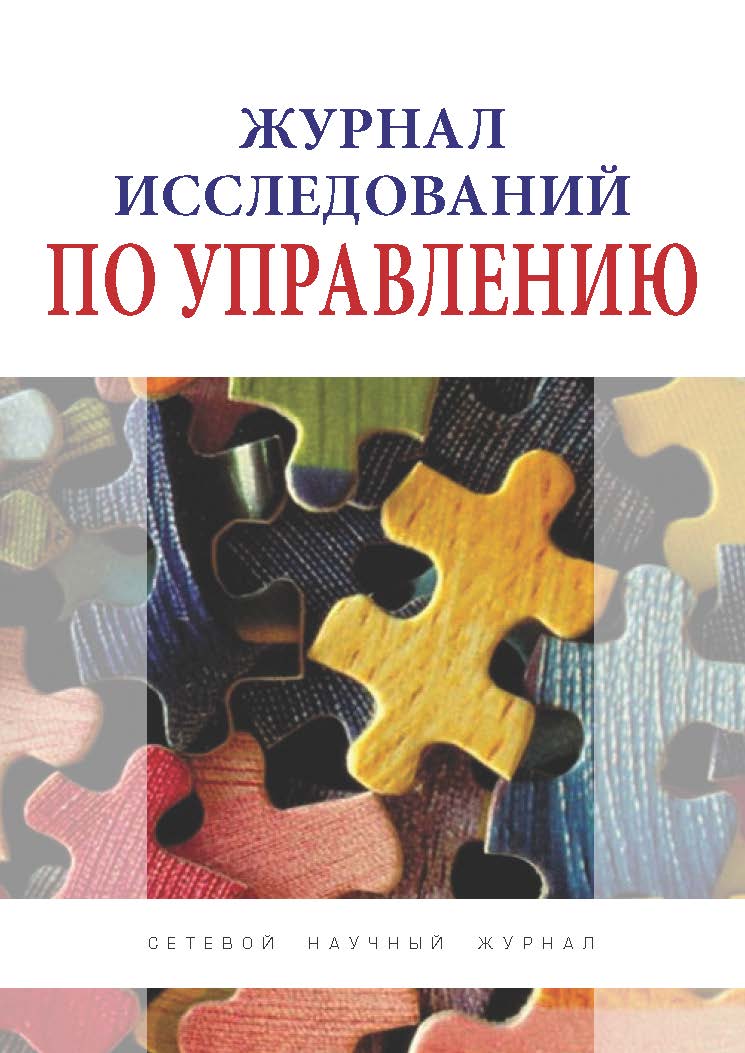с 01.04.2014 по 07.11.2018
Пенза, Пензенская область, Россия
с 01.01.2008 по настоящее время
Пенза, Пензенская область, Россия
В работе поднимаются ключевые проблемы субсидирования сельского хозяйства в России, выявленные на современном этапе формирования агропродовольственной политики страны. Показано, что наряду с усилением мер бюджетной поддержки сохраняется ее низкая доступность для большинства сельхозпроизводителей и диспропорция в распределении бюджетных средств между ними. Внедрение системы государственной поддержки через финансовые институты и кредитные структуры, с одной стороны, способствует привлечению огромных объемов коммерческих банков в аграрный сектор, что важно для снижения нагрузки на бюджет в условиях нестабильной конъюнктуры энергетического рынка. С другой стороны, жесткие условия кредитования благоприятствуют лишь редким хозяйствам с абсолютной финансовой устойчивостью, которые, в конечном итоге, получают львиную долю бюджетных ассигнований и одновременно становятся заложниками ситуации и долговой нагрузки. Другие хозяйства, имеющие приличные запасы земли, рабочей силы и капитала, лишены возможности задействовать свой ресурсный потенциал в общем процессе производства продуктов питания, что не отвечает стратегической задаче и единой концепции повышения продовольственной самообеспеченности. Обобщение основных положений экономической теории и опыта предоставления бюджетных трансфертов в западных странах показывает, что участие государственного бюджета в аграрной экономике менялось по мере решения поставленных перед отраслью приоритетов. Цели бюджетной поддержки ушли от необходимости снижения зависимости от импорта для поддержки доходов фермеров и сохранения сельских территорий с учетом природных и экономических условий, которые в нашей стране способствуют дифференциации регионов по уровню сельскохозяйственного потенциала и укреплению расслоения производителей по финансовым, экономическим и производственным параметрам развития. На основании этого в работе обоснован вывод о необходимости дополнительных стратегических мер дифференцированной поддержки сельского хозяйства, направленных на выравнивание экономических условий хозяйствования и создание единого экономического пространства страны.
бюджетные ассигнования, льготное кредитование, несвязанная поддержка доходов, сельскохозяйственный потенциал, дифференцированные субсидии
Introduction
More than ten years ago, a radical change came in the agriculture policy of Russia. The conditions, principles and mechanisms of state influence on the agriculture economy of the country have changed. The legal framework for the development of agriculture and food markets has undergone a profound transformation. The main difference from the documents of previous years lies in the substantial financial and resource support of the activities planned for today.
Nevertheless, there are still discussions about the possibilities of preserving and strengthening the positions of the domestic agro-industrial complex in the domestic and foreign food market [1, 14, 15, 23]. Numerous disputes arise on the basis of modernization of regulatory instruments and state support measures for agriculture [7, 10, 27, 32], which is especially important in connection with the formation and implementation of a new system of state planning and forecasting within the framework of the Federal Law “On Strategic Planning in the Russian Federation”.
The study of the problem of state regulation of the agriculture economy and the mechanisms of its manifestation should be based on certain methodological principles and methodological approaches that have developed within the framework of various economic schools, where the very awareness of the problem of relations between the state and market structures is different. Different points of view of scientists vary from providing complete freedom to business entities to the need for direct regulation of their business activities.
Theory and Methodology
Starting from the second half of the XIX century it became obvious that the economy is not able to develop successfully without any state intervention. Contrary to the generally accepted opinion, the founder of classical economic theory, A. Smith did not deny the activities of the state in the emerging market. He had to admit that the state is obliged to perform a number of functions designed to ensure the viability and efficiency of the economic system [30, p. 70].
According to the neoclassicists of the 20th century, the state, without interfering directly in the actions of market forces, should create favorable economic conditions for the effective functioning of the market and entrepreneurship [12, p. 71].The world economic crisis of 1929-1933 forced to take a fresh look at the mechanisms of the market. The theory of J. Keynes is that capitalism is not a self-regulating system it lacks internal equilibrium mechanisms. It proves the need for radical government intervention. The scientist advocated the use of state planning, financial and tax policies in order to regulate production, employment and inflation, which was the basis for the formation of US legislation on state agricultural policy [6].
The ideas of T. Veblen and his follower Wesley C. Mitchell include interfering in market relations by using public funds to eliminate economic imbalances, which also formed the basis of the US law on the creation of a public service to regulate prices for agricultural and industrial products, tightening control over the sale of and purchase of agricultural land [2].
State intervention, from the point of view of J.K. Galbraith, is necessary to solve the main problems of the modern economy, which is based on a contradiction between the planning and market systems [11, p. 4]. According to J.K. Galbraith, the state should take under its care the ecology, education, medicine [31, p. 132].
Among the bourgeois economists who are trying to “correct” capitalism, give it a socially oriented character through the active participation of the state in the economic life of society, the creators of the French planning system or “state dirigism” should be singled out. Professor of political economy of higher educational institutions of Lyon and Paris F. Perroux, in his works, justified the need for active state economic and social maneuvering in order to build a society of abundance and justice [16, p. 12].
In general, an analysis of economic theories leads to the conclusion that government regulation of a market economy has gone from a policy of state non-interference in a market economy to active state influence on the economy, from creating general favorable conditions for market self-regulation to direct regulation of economic processes, especially in the agricultural sector.
The need for a special agriculture policy is explained by the natural and economic characteristics of agricultural production, the special nature of food as a commodity, both from the point of view of producers and consumers [17, p. 15].
The idea that agriculture has a special nature, distinct from other sectors of the economy, permeates the entire European agricultural policy.
The specific features of agricultural production [8] are the explanation of the increased attention of most countries to the agriculture sector of the economy. Given these circumstances, developed market multi-channel agricultural support systems operate in most market economies.
The state allocates large funds annually to the functioning of the agricultural sector in developed countries. Even in the conditions of fulfilling WTO requirements, they are striving to minimize the damage from reducing support for the agricultural sector, and due to the restructuring of support measures, they manage to increase this [20, p. 70-71].
In the US, already the 30s. the last century, the active influence of the state on agriculture was determined by the peculiarities of the formation of demand for agricultural products, as well as the close dependence of the industry on the state of the world market for agricultural goods. Even then, the priority was the task of maintaining farm incomes at the level of incomes of people employed in the non-agricultural sector of the economy. An important place is given to maintaining the high competitiveness of American agricultural products in world commodity markets, maintaining a leading position in international trade [19].In recent years, changes in the form of agricultural subsidies have occurred in Western countries. In the USA, they implement budget support, differentiated depending on the income of farmers. In the European Community began to distribute budgetary funds among farmers based on the area of land, taking into account the natural and economic conditions [9].Thus, the agri-food sector is not self-sufficient and requires significant investments. However, there is simply no alternative to food and food production in the modern economy [18, p. 18].
Results
In Russia, with the development of legislation on agriculture and agriculture markets, there was an increase in state support measures. This led to an increase in budget allocations to agriculture, the mobilization of credit resources, and the attraction of private investment. According to the national report [26], budget support for the development of agricultural production and rural areas has grown to 222 billion rubles. in 2015, which is more than 11 times higher than the 2005 level. Due to the subsidization of the interest rate on bank loans, the total amount of credit resources issued to agribusiness organizations in 2015 amounted to almost $ 1 trillion. 130 billion rubles. This is very good, as there is no other way to attract such funds to the agricultural sector.
The policy of cheapening financial resources for agriculture has been implemented since the beginning of economic transformations, and today this trend is only growing. So, in the Penza region, in the general structure of the resource support of the state program for 2013-2020 subsidized interest rates on loans in the region is more than 45%. In 2019, the share of lending support from the regional budget is already 54%, of the federal 74%.
The overall credit rating indicates a deterioration in creditworthiness over the period analyzed. Lending to the borrower requires a balanced approach. It is possible to get a loan on ordinary and not on favorable terms. In 2017-2019, 4 models of bankruptcy forecasting show that the probability of default of enterprises in the agriculture sector is very high. In essence, this determines the weak interest of credit institutions in agriculture, even in the context of enhanced state guarantees for subsidizing interest rates on bank loans [29].

Fig. 1. Total credit rating of commodity producers of the Penza region
The development of agriculture due to the formation of relations between the agriculture and financial sectors of the economy does not allow the majority of agricultural organizations to act as equal partners of financial institutions; therefore, only financially sustainable farms can use the existing support tools, which, for the most part due to the saturation of production, cannot ensure efficiency gains from using such funds and receive them only at the expense of their status. Due to the support of a small part of strong farms, the overall level of economic development of the industry, social development of rural areas, etc. are not ensured.
According to our research [5], the current mechanism of state support, which stimulates the attraction of bank capital to the agriculture sector, creates conditions for the development of only part of the region’s farms, which makes up only 17% of all farms, they have a little more than 13% of farmland, and produce just over 20 % of marketable products of the region.
Obviously, new approaches to state support are needed, allowing to use growth reserves and improve the production efficiency of the majority of producers. The obtained results substantiate the need to create the same economic conditions for economic activity for the majority of commodity producers, which is possible by creating equal access to state support funds.
In recent years, another measure of state regulation of the agricultural sector has significantly intensified - unrelated income support. Serious expectations from this type of subsidies were pinned back in 2006, when the draft Federal Law “On the Development of Agriculture” was being considered. The special article "State support for the income level of agricultural producers' activity" provided for the provision of subsidies from the federal budget to all agricultural producers in the amount of 500 rubles. on one hectare of actual crops of agricultural crops and perennial plantings. However, the aforementioned provision was excluded from the final version of the law.
Currently, unrelated income support is distributed according to the principle of arable land use intensity. Again, only technologically equipped producers receive such subsidies. Their share among all farms is also relatively small, which indicates a lack of development in Russia of the mechanism for granting subsidies.
Today, the agricultural sector has a strategic task of import substitution in the food market. “Russia has no right to be vulnerable ... you need to set the task of the national level and by 2020 fully ensure the domestic market with domestic food ... become the world's largest supplier of healthy, environmentally friendly, high-quality food,” the President’s message to the Federal Assembly on December 3, 2015 says of the year [22].
There is a need for more effective mechanisms for the provision of state assistance to the village, allowing the use of fundamentally different in scale production reserves and administrative resources of agriculture.
From 2017, the allocation of agricultural subsidies is expected, taking into account their performance in previous years [23].The change in the mechanism of distribution of federal support to the regions is due to the need to increase the return on the use of budget resources in agricultural production in the context of their limited nature.
To assess the effectiveness of the implementation of expenditures of the budgets of the constituent entities of the Russian Federation, the source of financial support for which is a subsidy, the following performance indicators for the use of the subsidy are used (Figure 2).

Fig. 2. Subsidy performance indicators
And this is already a definite turning point in the formation of an effective strategy for the development of the agricultural sector. However, the methodology for the distribution of subsidies is structured in such a way that the agriculture potential of the regions and producers is not taken into account. With enormous differences in the natural and economic conditions between regions and within them, differentiated subsidies are required.
“Differences between the Russian regions exceed the differences between the richest and the poorest countries in the world” [13], because of this, 55–60% of agricultural enterprises in Russia operate in worse natural and economic conditions than other farms, and therefore the cost of their products is higher than the national average. In the Penza region, the difference in costs and output between farms reaches 10 or more times (Figure 3).

Fig.3. The dependence of gross output and profitabilityfrom the agriculture potential and the volume of support of the Penza region
The variety of activity conditions determines the different efficiency of living and embodied labor, which essentially affects the formation of the volume of the newly created product [24]. This contributes to the fact that farms with better conditions of activity receive a differentiated income. Moreover, support funds are more concentrated in farms that have better-quality agricultural land. The greater the amount of support and the higher the quality of farmland, the more significant the size of production, financial results and business performance.Moreover, regions with favorable factors of the natural and climatic environment have superiority over regions with less favorable rent-forming conditions in the level of formation of the physical and economic availability of high-quality products [21].
Differences in natural and economic conditions contribute to the polarization of agricultural producers in terms of production development and final results of operations, strengthen their economic stratification by financial state and financial stability. This must be taken into account when granting budget allocations. Due to the differentiation of support, taking into account the agriculture potential of the regions, it is possible to involve in the total turnover additional land, labor and other resources of other farms, thereby expanding the material and technical base of agricultural food production.
In the work, with the help of the Gretl software tool, models of the dependence of gross agricultural production (VP) on state support funds (SO) and cadastral value (CS) per 1 hectare of farmland were built:
VP = SO1.478 * CS-0.213
The significance of the model is confirmed by the correlation coefficient (0.995) and the Fisher's significance (1.64e-79), and the adequacy of the model parameters is proved by the P-value for the regressors SO (2.49e-076) and CS (0.0089).
The elasticity coefficients of the model show that an increase in subsidies by 1 rub. leads to an increase in gross output by 1 ruble. 48 kopecks, and an increase in the cadastral value by 1 ruble, on the contrary, to a decrease in gross production by 0.21 kopecks. This situation indicates that the competitive advantages of manufacturers, arising against the background of various natural and climatic conditions, are poorly used. This shortage has to be partially compensated for by means of state support.
Conclusions
Today, state support is an indisputable factor in the development of agriculture. With its help, the state solves important socio-economic national problems. The study of economic theory and international experience shows that the leading world powers used state support at first as a tool to reduce food dependence. As physical availability of food became the norm, government support became a function of farmers' income and the preservation of rural areas. In Russia at the present stage, the development of state support is associated with the attraction of the resources of financial and credit institutions to the agricultural sector. With all the correctness of this approach in conditions of a budget deficit, only financially stable agricultural firms that formally meet the requirements of creditworthiness and receive the bulk of bank capital, but are not able to solve the problem of ensuring the country's food security alone, become partners of the banking sector. At the same time, the agricultural potential of a significant part of the farms is not used. The results of the study show that it is important to link it with the natural and economic conditions of economic activity, which significantly affect the results of the agricultural and food policy. On the basis of state support, Western countries compensate for the disadvantages of climatic factors. In Russia, it is possible to neutralize the influence of natural and economic conditions on the results of management. With the help of state support, it is necessary to orient commodity producers to the production of those products that are most effective for business and the cheapest for consumers. This approach will make it possible to level the starting conditions of farms through the use of those competitive advantages of the regions that contribute to solving national food problems with the country's least agricultural resources, the costs of producers and the population.
1. Altukhov A.I. Food security and import substitution are the main strategic tasks of modern agrarian policy / A. I. Altukhov, V. V. Drokin, A. S. Zhuravlev // Economy of the region. - 2015. - №3. - p. 256-266. doi 10.17059 / 2015-3-21.
2. Avtonomov V. History of Economic Studies / V. Avtonomov, O. Ilina, N.N. Makishev. - M.: Infra, 2000. - 319 p.
3. Baryshnikov N.G. Assessment of the natural-economic potential and conditions for the emergence of differentiated income in the region's agriculture / N.G. Baryshnikov, D.Yu. Samygin // Regional economy: theory and practice. - 2012. - № 18 (249). - p. 16-24
4. Baryshnikov N.G. Solvency management in agriculture: economic and statistical aspect (on the example of the Penza region)/ N.G. Baryshnikov, D.Ju. Samygin // Statistics issues. - 2015. - No 1. - pp. 65-76.
5. Besaphotny G.V. Tasks of state planning of the agroindustrial complex and methods for their solution // Economics of Agriculture of Russia. - 2015. - № 5. - p. 2-7.
6. Besaphotny G.V. The ratio of sources of financing of agriculture / G.V. Besaphotny, N.G. Baryshnikov, D.Yu. Samygin // Niva Volga. - 2011. - № 3 (20). - p. 2-7
7. Borisov E.F. Economic theory: studies. / E. F. Borisov. - M.: Yurait-M, 2002. - 384 p.
8. State regulation of market economy: studies. / under the general ed. V.I. Kushlin. - Ed. 2nd, Pererab. and add. - M.: RAGS, 2002. - 832 p. (in translation)
9. Granberg A.G. Regional economics and regional science in Russia: ten years later / A. G. Granberg // Region: economics and sociology. - 2004. - № 1. - p. 57-81.
10. Zlochevsky A., Korbut A. Efficiency of the state support of the agricultural sector // Moscow Economic Journal. - 2015. - № 2.
11. Karkh DA Priority areas for improving the efficiency of the regional food complex / D.А. Karh, V.M. Gayanova, F. Aimel // Economy of the region. - 2015. - №2. - p. 260 - 271
12. Klimov S. M. State regulation of the economy in the region: a course of lectures for students of economics. specialties / S. M. Klimov, I. L. Matsenovich, A. M. Khodachek. - SPb. Knowledge, IWESEP, 2005.- 148 p.
13. Nazarenko V.I. Agrarian Policy of the European Union / V.I. Nazarenko. - M.: Market DS Corporation, 2004. - 362 p.
14. NazarenkoV.I. J.M. Keynes and his contribution to economic and agrarian theory / V.I. Nazarenko, // Economics of agricultural and processing enterprises. - 2005. - № 6. - P. 14-18.
15. Paptsov A. G. State regulation of agriculture (current trends and prospects): author. dis. ... Dr. Econom Sciences / Paptsov AG, - M., 1998. - 36 p.
16. Paptsov A. Directions of state support of agriculture in developed countries of the USA / A. Paptsov // AIC: economics, management. - 2005. - № 11. - p. 69-72.
17. Poskus B. Alignment of economic conditions of management. Vilnius: Moxlas. 1979. 202 p.
18. Smith A. Study on the nature and causes of the wealth of nations: in 2 t. / A. Smith. - M. L., 1935. - T. 2. - p. 258.
19. Economics: studies. / ed. Dr. Econ. sciences, prof. A. S. Bulatov. - 3rd ed., Pererab. and add. - M.: Yurist, 2002. - 896 p.
20. SamyginD.Yu. Modeli prognozirovaniya strategicheskogo razvitiya sel'skogo hozyaystva / D.Ju. Samygin, N.G. Baryshnikov // Models, systems, networks in economics, technology, nature and society. - 2015. - No 1(13). - pp. 81-86.
21. Strategic models of optimization of support of farmers / D. Samygin, N. Baryshnikov, L. Vinnichek, I. Glasunov // Ponte. - 2017. - Vol. 73. - No 4. - pp. 146-157.









